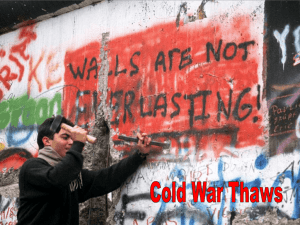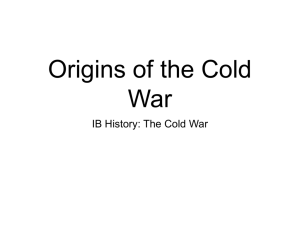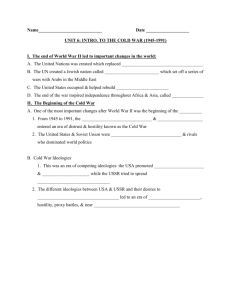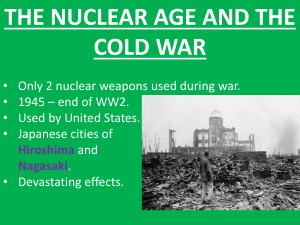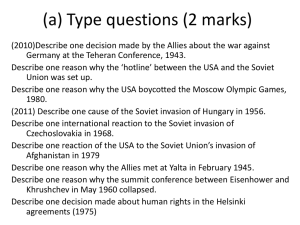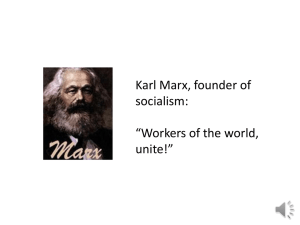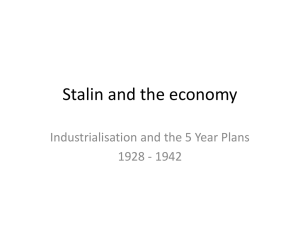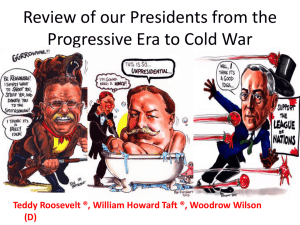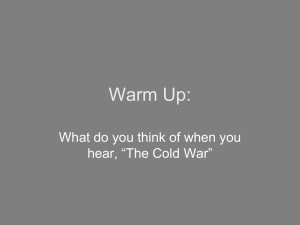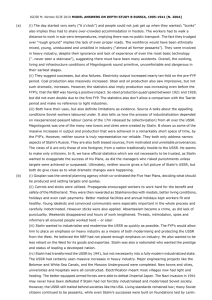Powerpoint
advertisement
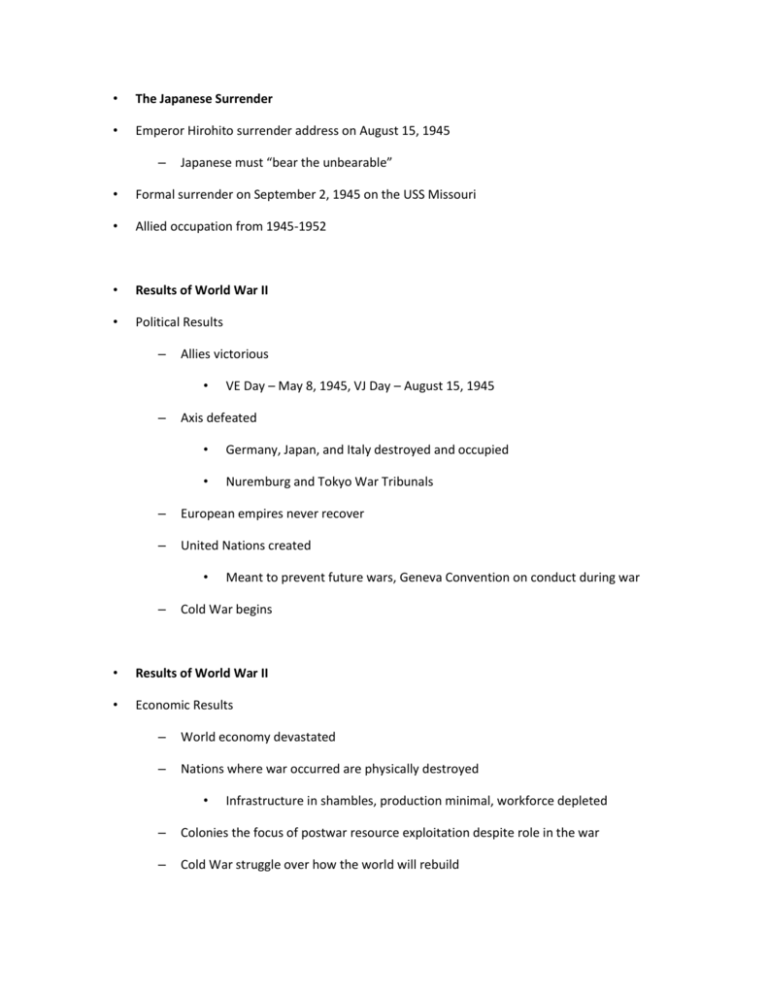
• The Japanese Surrender • Emperor Hirohito surrender address on August 15, 1945 – Japanese must “bear the unbearable” • Formal surrender on September 2, 1945 on the USS Missouri • Allied occupation from 1945-1952 • Results of World War II • Political Results – Allies victorious • – VE Day – May 8, 1945, VJ Day – August 15, 1945 Axis defeated • Germany, Japan, and Italy destroyed and occupied • Nuremburg and Tokyo War Tribunals – European empires never recover – United Nations created • – Meant to prevent future wars, Geneva Convention on conduct during war Cold War begins • Results of World War II • Economic Results – World economy devastated – Nations where war occurred are physically destroyed • Infrastructure in shambles, production minimal, workforce depleted – Colonies the focus of postwar resource exploitation despite role in the war – Cold War struggle over how the world will rebuild • Results of World War II • Human Cost – ~70,000,000 Dead • – ~160,000,000 Wounded • – 10 million killed Japanese Democide • – Injured in combat or from war related famine and disease Holocaust (genocide) • – Deadliest war in world history 5.5 million killed Axis Civilian Deaths • 5 million killed • Growing Distrust • WWII alliances quickly break after the end of the war • Yalta Conference, 1945 • – Stalin pledges to hold free elections in Soviet occupied Eastern Europe, instead sets up a belt of communist buffer states – “An iron curtain has descended across the continent.” – Winston Churchill – Bipolar world established between the US and the USSR, all other nations pushed to take sides USSR tests atomic bomb Sept. 1949 – • The Arms Race The Cold War was a global competition between the US and the USSR – Arms race: a contest in which nations compete to build more and more powerful weapons based on the fear of war (nuclear) – In 1952 US explodes a hydrogen bomb, USSR soon follows, China has a nuclear weapon in 1964, H-bomb soon after, UK and France develop nuclear weapons as well • The Arms Race • Mutually Assured Destruction – The idea that if you have a large enough nuclear arsenal then no one would attack you or risk destruction themselves – Weapons are stockpiled or collected as a deterrent all the way through the 1970s, US and USSR have enough to destroy the world many times over – Not only nuclear weapons were stockpiled, other weapons of mass destruction and conventional military strength are increased • What is a Cold War? • A state of international relations in which the world was divided into two ideological camps. Each side wanted to avoid military confrontation, but both accepted it as a possibility and prepared for it. – Free World Leader United States – Communist World Leader Soviet Union – There could be no neutrality…war was expected though it was not wanted. • Soviet Expansion • At the end of WWII communist groups began to gain power all over Europe, Eastern Europe becomes part of the Soviet sphere of influence • Stalin asserts his military strength, goal to become the world’s leading superpower • The Truman Doctrine – President Truman declares that the United States must contain the spread of communism worldwide, policy deemed containment – Use of both military and economic aid to countries in need in war torn Europe and the developing world • The Recovery in Europe • Europe rebuild under both US and USSR stewardship but never recovers its imperial power • The Marshall Plan, 1947 – European economies struggle to rebuild after WWII, US steps in to help between 1948 and 1951 – Hugely successful in building alliances with European nations and rebuilding critical infrastructure • The German Issue • The focus of early Cold War hostilities fell on a divided Germany • – Germany and its capital Berlin divided into 4 zones – In 1948 the Western powers wanted to reunite Germany, Stalin opposed – Stalin blockades the city of Berlin, hope Western powers will back down, instead they respond with a massive airlift of supplies “Berlin Airlift” – Soviet blockade ends in 1948, Germany becomes West Germany and East Germany – The German Issue The divided Germany remained the focus of Cold War tensions – Between 1949 and 1961 thousands of East Germans fled Stalin’s iron fist to West Berlin – Suddenly in August 1961 the East German government started building the Berlin Wall which stood as a symbol of division for 28 years until 1989 • The Cold War Moves to Space • The Soviets launch the world’s first satellite into space in October 1957 – The satellite’s name was Sputnik, 184 pounds, circled the earth at 18,000 miles-per-hour – Space race begins as the US tries to catch up – Fear that the USSR could hit any US city with a nuclear weapon – Want to develop tech to control outer space – US Congress creates the National Aeronautics and Space Administration (NASA) and passes the National Defense Education Act to produce more scientists and teachers • International Organizations • The United Nations – US plays the leading role in the creation of the United Nations, ends US isolationism – Goal of the UN was to resolve disputes between countries and prevent future wars – Has a General Assembly of all nations and a Security Council to make military decisions – • 15 members, 10 rotate • 5 Permanent Members are US, USSR (Russia), China, UK, and France • Each of the 5 has veto power UN has accomplished a great deal in providing for international relief • Dueling Organizations • NATO and the Warsaw Pact – US and allies establish the North Atlantic Treaty Organization – USSR and allies establish the Warsaw Pact – An attack on any member would spark a war between all • Soviet Union During the Cold War • Soviet Union doesn’t win much in WWII, things don’t get better for the people • Stalin dies in 1953 and is replaced by Nikita Khrushchev • – Destalinization of the USSR, “Peaceful Coexistence,” and closed labor camps – Leonid Brezhnev cracks down as Soviet Premier from the mid 1960s through the 1980s – Uprisings in East Germany (1953), Hungary (1956), and Poland (1968) “Prague Spring” – Desire for greater freedoms, all put down by Soviet troops – Andre Sakharov and Aleksandr Solzhenitsyn lead criticisms of corruption and mismanagement in the Soviet Union – United States During the Cold War United States economy comes roaring back after WWII, greatest period of prosperity in US history – Driven by the GI Bill, a culture of consumerism, and franchizization of American business – Roots of both the modern Democratic and Republican parties in the politics of the 1950s and 1960s • Red scare and Cold War paranoia • Culture of conformity battles with counterculture (beats, hippies, punks)
